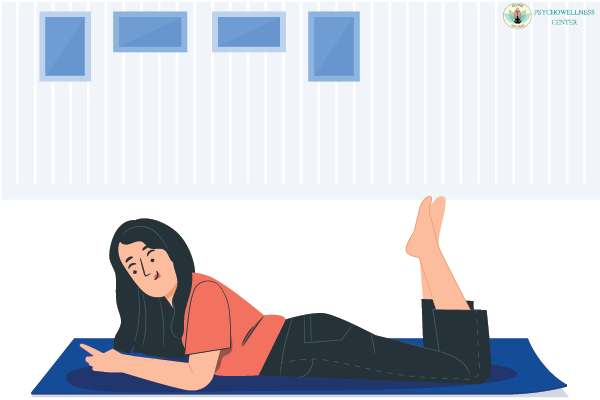A form of therapy known as Jacobson’s relaxation technique focuses on progressively contracting and relaxing particular muscle groups. The term which is often used is “progressive relaxation therapy“. You can increase your awareness of your body and its physical sensations by focusing on specific places, tensing them, and then relaxing them. The method was created in the 1920s by Dr. Edmund Jacobson to help and support his patients in coping with anxiety. Dr. Jacobson believed that calming the muscles may also calm the mind. In this method, one muscle group is tightened while the rest of the body is kept relaxed. The tension is then released.
Your muscles are probably stiff quite a bit if you have an anxiety disorder, such as Social anxiety disorder (SAD) or generalized anxiety disorder (GAD). You will discover how a relaxed muscle feels different from a tight muscle by practicing PMR. In most cases, systematic desensitization and other cognitive behavioral treatment strategies, including progressive muscle relaxation, are combined. However, using the technique by yourself will give you more control over how your body reacts to anxiety.
Uses of Progressive Muscle Relaxation
The benefits of progressive muscle relaxation include the following:
-
Anxiety
-
elevated blood pressure
-
a lower back pain
-
Migraine
-
tense muscles
-
a sore neck
-
Stress
Chronic stress and anxiety can be a factor in several health issues. Depression, diabetes, heart disease, and irritable bowel syndrome are among the health issues connected to chronic stress.
Possible health benefits
Many different health advantages can result from using relaxation techniques, including:
-
Reducing tension
-
Lowering stress at work
-
Decreasing blood pressure
-
Lowering the risk of seizures and enhancing sleep
Perhaps since stress plays a role in high blood pressure, research demonstrates a link between relaxation and blood pressure. Jacobson’s relaxation technique may assist persons with epilepsy to reduce the severity and frequency of their seizures, according to both old and current research. We need larger sample sizes.
Steps of progressive muscle relaxation technique
Choose a peaceful area that’s not busy. Loosen any restrictive clothing, lie on the floor or lie back in a chair, and take off your glasses or contacts. Your hands can be elevated on the chair’s arms or in your lap. Take several deep, regular breaths. Spend a few minutes practicing diaphragmatic breathing if you haven’t previously.
Now, concentrate on the following areas while being mindful to keep the rest of your body relaxed.
- Forehead: Squeeze your forehead muscles and hold for 15 seconds. Feel your muscles getting tense and stronger. Then, while counting for 30 seconds, gradually let go of the tension in your forehead. As you relax, pay attention to the difference in how your muscles feel. When your forehead is completely relaxed, keep letting go of the tension. Breathe evenly and gradually.
- Jaw: Tense your jaw muscles, keeping the position for 15 seconds. Then slowly let go of the tension as you continue to count for 30 seconds. Continue to breathe gently and evenly while taking note of how relaxed you are.
- Neck and shoulders: Raise your shoulders toward your ears and hold for 15 seconds to tighten your neck and shoulders. As you slowly let go of the stress, start the 30-second countdown. Observe how the tension is relieved.
- Hands and arms: Make fists slowly with both hands. Press your fists to your chest, squeezing as hard as you can, and hold for 15 seconds. After 30 seconds, slowly release your grip while keeping your count going. Make a note of how relaxed you feel..
- Buttocks: For 15 seconds, gradually tighten your buttocks. Then, over the next 30 seconds, gradually let the tension go. Observe how the tension eases. Breathe evenly and gently like before.
- Legs: For 15 seconds, gradually tighten your calf muscles and thighs. Intensify your muscle contractions. After that, release the tension bit by bit for a whole thirty seconds. See how the calm persists while the tension dissipates.
- Feet: Put more pressure on your toes and feet gradually. Attempt to get the muscles as tight as you can. Next, steadily let go of the tension while you continue to count for 30 seconds. Observe how the tension dissolves. Continue to breathe evenly and slowly.
Enjoy this feeling of being relaxed with slow and even breathing. You can consult a therapist by searching for the “Best psychologist near me” or clinical psychologist to get guidance on learning JPMR.
Tips for progressive muscle relaxation
-
Even though PMR can be practiced at any time, wearing comfortably may encourage deeper relaxation. Consider wearing loose, lightweight clothing.
-
For practice, allow 15 to 20 minutes.
-
Do PMR is a place where you may perform quietly, comfortably, and without interruptions.
-
Inhale deeply as you perform PMR. Check to see if you are holding your breath or breathing too quickly.
-
When you initially start, make it a point to practice while you are at ease. Your body will be easier to relax as a result.
For mild to severe anxiety, relaxing techniques like progressive muscle relaxation can be useful. It can be especially beneficial When combined with more traditional forms of treatment like medicine or cognitive-behavioral therapy. However, it is important to speak with a Best psychologist delhi, Online counselor, or the Therapists in delhi if you are showing clear signs of anxiety or chronic stress to receive the proper treatment.
Make an appointment for mental health therapy with the Psychowellness Centre. renowned and knowledgeable psychologists. NOIDA, Janakpuri, Dwarka, Faridabad, and Delhi NCR are all close to the facility.
Contribution: Dr (Prof) R K Suri, Clinical Psychologist, life coach & mentor TalktoAngel & Dr. Sakshi Kochhar

